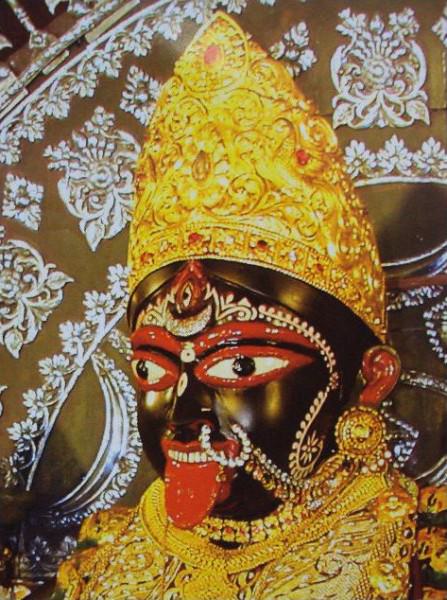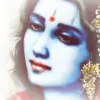Collected from different websites
Kali
The story of the goddess Kali is told in the Devi Mahatmya of the Markandeya Purana. She is an incarnation of the goddess Durga. For those who don't know, Durga was created from the combined powers of Brahma, Vishnu, and Shiva in order to defeat the demon Mahishasura. But she is generally viewed be the consort of Shiva, because she is considered an incarnation of Shiva's wife Parvati. (Or if you're a follower of the Shakta sect, then you'd view Durga to be a manifestation of the same Adi Parashakti of which Shiva's wives Shakti and Parvati were both incarnations.)
In any case, the story of Kali happened after Durga's victory over Mahishasura. Once the demons Shumba and Nishumba defeated the gods in battle and took over the three worlds, so the gods went to mount Kailash to ask Durga for help. After they said a prayer to Durga, Shiva's wife Parvati came by, and out of her body came a form of Durga known as Ambika or Kaushiki. During Ambika's battle with the Shumba and Nishumbha's Asura army, she was confronted by a pair of Asura generals named Chanda and Munda. To defeat them, Ambika created Kali out of her forehead, as described in this chapter of the Devi Mahatmya of the Markandeya Purana:
Thereupon Ambika became terribly angry with those foes, and her anger her countenance then became dark as ink. Out from the surface of her forehead, fierce with frown, issued suddenly Kali of terrible countenance, armed with a sword and noose. Bearing the strange skull-topped staff, decorated with a garland of skulls, clad in a tiger's skin, very appalling owing to her emaciated flesh, with gaping mouth, fearful with her tongue lolling out, having deep-sunk reddish eyes and filling the regions of the sky with her roars, and falling upon impetuously and slaughtering the great asuras in that army, she devoured those hosts of the foes of the devas.
Kali defeated Chanda and Munda and brought Ambika their heads, for which she is known as Chamunda or Chamundeshwari. And she was instrumental in helping Ambika defeat Shumbha and Nishumbha and restore rule of the three worlds to Indra and the gods.
Kali is the Hindu goddess (or Devi) of death, time, and doomsday and is often associated with sexuality and violence but is also considered a strong mother-figure and symbolic of motherly-love. Kali also embodies shakti - feminine energy, creativity and fertility - and is an incarnation of Parvati, wife of the great Hindu god Shiva. She is most often represented in art as a fearful fighting figure with a necklace of heads, skirt of arms, lolling tongue, and brandishing a knife dripping with blood.
Name & Worship
Kali's name derives from the Sanskrit meaning she who is black' or she who is death', but she is also known as Chaturbhuja Kali, Chinnamast, or Kaushika. As an embodiment of time Kali devours all things, she is irresistibly attractive to mortals and gods, and can also represent (particularly in later traditions) the benevolence of a mother goddess.
The goddess is particularly worshipped in eastern and southern India and specifically in Assam, Kerala, Kashmir, Bengal, - where she is now worshipped in the yearly festival of Kali Puja held on the night of a new moon - and in the Kalighat Temple in the city of Calcutta.
Kali's Birth
There are several traditions of how Kali came into existence. One version relates when the warrior goddess Durga, who had ten arms each carrying a weapon and who rode a lion or tiger in battle, fought with Mahishasura (or Mahisa), the buffalo demon. Durga became so enraged that her anger burst from her forehead in the form of Kali. Once born, the black goddess went wild and ate all the demons she came across, stringing their heads on a chain which she wore around her neck. It seemed impossible to calm Kali's bloody attacks, which now extended to any wrongdoers, and both people and gods were at a loss what to do. Fortunately, the mighty Shiva stopped Kali's destructive rampage by lying down in her path, and when the goddess realised just who she was standing on, she finally calmed down. From this story is explained Kali's association with battlegrounds and areas where cremation is carried out.
In another version of the goddess' birth, Kali appeared when Parvati shed her dark skin which then became Kali, hence one of her names is Kaushika (the Sheath), whilst Parvati is left as Gauri (the Fair One). This story emphasises Kali's blackness which is symbolic of eternal darkness and which has the potential to both destroy and create.
In a third version, men and gods were being terrorised by Daruka who could only be killed by a woman, and Parvati was asked by the gods to deal with the troublesome demon. She responded by jumping down Shiva's throat. This was because many years previously Shiva had swallowed halahala, the poison which had risen from the churning of the ocean during the creation and which had threatened to pollute the world. By combining with the poison still held in Shiva's throat, Parvati was transformed into Kali. Leaping from Shiva's throat in her new guise, Kali swiftly despatched Daruka and all was well with the world once more.
Kali & Raktabija
Finally, in yet another version of Kali's birth, there is the story of the terrible demon Raktabija (Blood-seed). This demon was, like most demons, causing a great deal of trouble with people and gods alike but even worse was his ability to produce more demons every time a drop of his blood spilt to the ground. Therefore, each time Raktabija was attacked, the only result was more demons to deal with. The gods decided to work together and combine all of their shakti or divine energy and produce one super being that could destroy Raktabija; the result was Kali (in another version only Durga produces Kali). Given all the divine weapons of the gods, Kali swiftly sought out Raktabija and his demons and proceeded to swallow them all whole so as not to spill anymore blood in the process. Raktabija himself was killed when Kali lopped off his head with a sword and then drank all of his blood, making sure none fell to the ground and thereby ensuring no more demons could menace the world.
Another famous story involving Kali is her escapade with a band of thieves. The thieves wanted to make a human sacrifice to Kali, and unwisely chose a Brahmin monk as a likely victim. Dragging him to the nearest temple, the thieves prepared to make the sacrifice in front of the statue of Kali when suddenly the statue came to life. Outraged at the thieves' plan to kill a monk, the goddess took swift revenge and decapitated the whole gang, even tossing their heads about for fun, whilst naturally the Brahmin escaped to continue his life of scholarly reflection.
Kali In Hindu Art
In art Kali is most often portrayed with blue or black skin, naked, and wearing a Bengali type crown of clay which is painted or gilded. She is, like many Hindu deities, a multiple armed figure with the number of arms being four, eight, ten, twelve, or even eighteen. Each arm usually holds an object and these can include a sword, dagger, trident, cup, drum, chakra, lotus bud, whip, noose, bell, and shield. Sometimes her left hand forms the abhaya mudra, whilst the right makes the offering varada mudra. She is often represented seated with legs crossed and having eight feet.
Kali's most common pose in paintings is in her most fearsome guise as the slayer of demons, where she stands or dances with one foot on a collapsed Shiva and holds a severed head. She wears a skirt of severed human arms, a necklace of decapitated heads, and earrings of dead children, and she often has a terrifying expression with a lolling tongue which drips blood.
The story of the goddess Kali is told in the Devi Mahatmya of the Markandeya Purana. She is an incarnation of the goddess Durga. For those who don't know, Durga was created from the combined powers of Brahma, Vishnu, and Shiva in order to defeat the demon Mahishasura. But she is generally viewed be the consort of Shiva, because she is considered an incarnation of Shiva's wife Parvati. (Or if you're a follower of the Shakta sect, then you'd view Durga to be a manifestation of the same Adi Parashakti of which Shiva's wives Shakti and Parvati were both incarnations.)
In any case, the story of Kali happened after Durga's victory over Mahishasura. Once the demons Shumba and Nishumba defeated the gods in battle and took over the three worlds, so the gods went to mount Kailash to ask Durga for help. After they said a prayer to Durga, Shiva's wife Parvati came by, and out of her body came a form of Durga known as Ambika or Kaushiki. During Ambika's battle with the Shumba and Nishumbha's Asura army, she was confronted by a pair of Asura generals named Chanda and Munda. To defeat them, Ambika created Kali out of her forehead, as described in this chapter of the Devi Mahatmya of the Markandeya Purana:
Thereupon Ambika became terribly angry with those foes, and her anger her countenance then became dark as ink. Out from the surface of her forehead, fierce with frown, issued suddenly Kali of terrible countenance, armed with a sword and noose. Bearing the strange skull-topped staff, decorated with a garland of skulls, clad in a tiger's skin, very appalling owing to her emaciated flesh, with gaping mouth, fearful with her tongue lolling out, having deep-sunk reddish eyes and filling the regions of the sky with her roars, and falling upon impetuously and slaughtering the great asuras in that army, she devoured those hosts of the foes of the devas.
Kali defeated Chanda and Munda and brought Ambika their heads, for which she is known as Chamunda or Chamundeshwari. And she was instrumental in helping Ambika defeat Shumbha and Nishumbha and restore rule of the three worlds to Indra and the gods.
Bhadrakali
| Bhadrakl (Good Kali, Mahamaya Kali) | |
|---|---|
 Bhadrakali worshipped by the Trimurti the male Trinity in the North Indian Basohli style. | |
| Devanagari | |
| Sanskrit Transliteration | |
| Tamil script | |
| Malayalam | |
| Affiliation | Devi |
| Mantra | o glau bhadraklyai nama |
| Weapon | Trident, Scimitar, Sword, Cleaver, Discus, Conch Shell, Spear, Mace, Vajra, Shield, Waterpot, Drinking Bowl, Goad, Dagger, Demon head |
| Consort | Virabhadra |
| Region | Southern India |
Bhadrakl (Sanskrit: , Tamil: , Telugu: , Malayalam: , Kannada: , Kodava: ) (literally "Good Kali,")[1] is a Hindu goddess popular in Southern India. She is one of the fierce forms of the Great Goddess (Devi) mentioned in the Devi Mahatmyam. Bhadrakali is the popular form of Devi worshipped in Kerala as Sri Bhadrakali and Kariam Kali Murti Devi. In Kerala she is seen as the auspicious and fortunate form of Kali who protects the good. It is believed that Bhadrakli was a local deity that was assimilated into the mainstream Hinduism, particularly into Shaiva mythology. She is represented with three eyes, and four, twelve or eighteen hands. She carries a number of weapons, with flames flowing from her head, and a small tusk protruding from her mouth. Her worship is also associated with the Tantric tradition of the Matrikas as well as the tradition of the ten Mahavidyas and falls under the broader umbrella of Shaktism.
Contents
[show]Etymology
In Sanskrit, Bhadra means good.[1] A major religious interpretation of this name is that Bhadra comes from 'Bha' and 'dra', The letter 'Bha' means 'delusion' or 'Maya' in Devanagiri and 'dra' is used as a superlative i.e. meaning 'the most/the greatest e.t.c' which makes the meaning of Bhadra as Maha Maya.[2][3] The Sanskrit word 'Bhadra Kali' therefore can be translated to Hindi as 'Mahamaya Kali'.
Origins
There are at least three traditional versions regarding the origin-incarnations or avatar of Bhadrakali. The first version is from Devi Mahatmyam and basically a part of Shaktism, and it was during the battle between Raktabija and Shakti, according to this tradition. The second is associated with the Daksha and Dakshayaga, from the more Shaivism related tradition, and glimpses of this version can be seen in some Puranas. The third and the equally most famous one is her divine birth as the daughter of Shiva to liberate the world from demon Daruka.
According to the Vayu Purana and the Mahabharata, Bhadrakali came into being by Devi's wrath, when Daksha insulted Shiva, during the great Ashvamedha Yagna (horse sacrifice).[4][5]
According to Tantra Rahasya, she arose from the North (Uttaramnaya) face (Amnayas) of Shiva, which is blue in color and with three eyes.[6]
Story of Darika
The demon Darika, after intense ascetic penances and practices, secured a boon from Lord Brahma that he would be invincible and would not get killed by any man. He began to harass the world and commit numerous crimes. When Lord Shiva came to know about the misdeeds of demon Darika, he became infuriated and created the Goddess Bhadrakali to kill the demon. Full of wrath, he opened his fiery third eye and the massive flaming form of Bhadrakali emerged. She was huge, wore a ferocious look and had countless heads, hands and legs. When Shiva requested Bhadra Kali to destroy Darika, she went through a forest and sought the help of bloodthirsty ghosts and spirits who lived there. When Darika saw Bhadrakali and her largely female army coming, he laughed and dismissed her, forgetting that his boon of invincibility did not pervent his being killed by a woman. After a fierce battle, Bhadrakali and her assistants finally finished him off, and the Goddess began to return home from Kailash, full of wrath and excitement and holding the head of Darika in her left hand. When she reached Kailash, her father Shiva tempted to calm her wrath by dancing naked before her and offering her worship. She was satisfied and henceforth began to receive offerings from devotees as a boon from Shiva.
Various traditions and forms of worship
According to her Keralan devotees, the events described in the Markandeya Purana associated with Bhadrakali (her slaying of the demon Daruka to liberate the universe from the evil) took place in Kerala, near Madayi in the Kannur District.[7] Bhadrakali temples in Kerala commemorate this event during traditional festivals and Bhadrakali is worshipped as the daughter of Lord Shiva, from whose third eye she sprung to defeat the demon. According to the Markandeya Purana, her worship purifies the devotee and grants liberation from the cycle of birth and death.[8] She is seen to protect the honour of women and to bestow all spiritual knowledge. In Kerala, she called Virabhadra her "brother" and refused to be treated by him when she was attacked by the deity Vasoorimala, who had marked her face with smallpox. She said that a brother must not touch the face of his sister. Thus, mild pockmarks are sometimes visible on her face in some Keralan depictions of her.[4][9]
Among the people of the neighboring states, especially in Tamil Nadu, this form of Shakti is known as 'Malayala Bhagavathy' or 'Malayala Bhadrakali', who provides protection to her devotees irrespective of caste and religion.
In Tamil Nadu, Karnataka, Andhra Pradesh and the Southern Travancore area of Kerala, especially in the city of Thiruvananthapuram, the Tamil, Kannada and Telugu speaking communities worship a form of Mahakali as 'Ujjaini Mahakali', and they consider Emperor Vikramaditya as their first teacher in this spiritual tradition as having established the tradition in the South.
In other parts of India, the Tantric name 'Kali' or 'Mahakali' is generally more popular as the consort of Shiva in his form of Rudra or Mahakala, and Bhadrakali is identified as Durga's daughter who helped her during the battle with Raktabija. Other sources state that she is the sister of Virabhadra, who was himself born of the wrath of Shiva as Rudra, and that she is the consort of a form of Mahakala or Bhairava. The deeply Tantric-influenced traditions mostly consider 'Kali' as the consort of Shiva.

Goddess Bhadrakali, gouache on paper (ca. 166070)
Martial arts and Bhadrakali
It is believed Bhadrakali protects the practitioners of Kalarippayattu, a traditional martial arts form. In Malabar, it is believed that all the victories of Thacholi Othenan and other martial artists were due to the blessings of Bhadrakali of the Lokanarkavu Temple, also known as 'The Shaolin Temple of Malayalees'. Most traditional villages in Kerala have their own Kalari, the ancient martial arts schools and local temples dedicated to Bhadrakali associated with them. Among Tamils, Bhadrakali is equally important as the patron deity of traditional martial arts and a guardian of all law abiding citizens.
Family deity of communities
Some communities, like the Kodavas and Nairs, worship this deity as family deity. They worship certain weapons at their temples which they believe to be the weapons used by the goddess. The Kuladevata or community deity of Kudumbi community is Kodungalluramma,the mother goddess of kodungallur. Kodungallur Bhagavathy Temple is one of the most famous temples in Kerala, dedicated to Bhadrakali. During the 'thalappoli' festival, which is celebrated mainly on Makar Sankranti, kudumbi people from all over the state (especially South Kerala) come to the temple. Bhadrakali is also the tutelary deity of the Nadar community of Tamil Nadu.[10]
Kalidasa and Vikramaditya
According to legends, the famous Indian Sanskrit poet Kalidasa became what he was thanks to the divine will of Bhadrakali. Another legend states that the emperor Vikramaditya and his brother Bhatti were also ardent devotees of Bhadrakali, whose blessings resulted in all the success showered upon them. Vikramaditya also helped to establish small wayside Bhadrakali temples and prayer centers for pilgrims in many parts of Southern India, especially in Tamil Nadu. The devotional traditions focused around these small temples exist even today.[11]
Folk Art ritual of Kerala and Bhadrakali

Murti of Bhadrakali in Madurai Meenakshi Temple
Kerala has a tradition of folk artist rituals and dances associated with worship of Devi in the form of Bhadrakali. These rituals are performed in places of worship called Kavu (roughly translated as grove) or in small temples. Besides the general welfare of the village, these rituals aim at warding off of such calamities like smallpox and other epidemic diseases. The ritual themes generally revolve around the triumph of Bhadrakali over the demon Daruka and other evil characters.




























